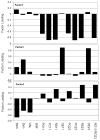Sensitivity and specificity of eustachian tube function tests in adults
- PMID: 23868429
- PMCID: PMC3792585
- DOI: 10.1001/jamaoto.2013.3559
Sensitivity and specificity of eustachian tube function tests in adults
Abstract
Importance: The study demonstrates the utility of eustachian tube (ET) function (ETF) test results for accurately assigning ears to disease state.
Objectives: To determine if ETF tests can identify ears with physician-diagnosed ET dysfunction (ETD) in a mixed population at high sensitivity and specificity and to define the interrelatedness of ETF test parameters.
Design, setting, and participants: Through use of the forced-response, inflation-deflation, Valsalva, and sniffing tests, ETF was evaluated in 15 control ears of adult subjects after unilateral myringotomy (group 1) and in 23 ears of 19 adult subjects with ventilation tubes inserted for ETD (group 2). Data were analyzed using logistic regression including each parameter independently and then a step-down discriminant analysis including all ETF test parameters to predict group assignment. Factor analysis operating over all parameters was used to explore relatedness.
Exposures: ETF testing.
Main outcomes and measures: ETF parameters for the forced response, inflation-deflation, Valsalva, and sniffing tests measured in 15 control ears of adult subjects after unilateral myringotomy (group 1) and in 23 ears of 19 adult subjects with ventilation tubes inserted for ETD (group 2).
Results: The discriminant analysis identified 4 ETF test parameters (Valsalva, ET opening pressure, dilatory efficiency, and percentage of positive pressure equilibrated) that together correctly assigned ears to group 2 at a sensitivity of 95% and a specificity of 83%. Individual parameters representing the efficiency of ET opening during swallowing showed moderately accurate assignments of ears to their respective groups. Three factors captured approximately 98% of the variance among parameters: the first had negative loadings of the ETF structural parameters; the second had positive loadings of the muscle-assisted ET opening parameters; and the third had negative loadings of the muscle-assisted ET opening parameters and positive loadings of the structural parameters.
Conclusions and relevance: These results show that ETF tests can correctly assign individual ears to physician-diagnosed ETD with high sensitivity and specificity and that ETF test parameters can be grouped into structural-functional categories.
Figures


References
-
- Bluestone CD, Doyle WJ. Anatomy and physiology of eustachian tube and middle ear related to otitis media. J Allergy Clin Immunol. 1988 May;81(5 Pt 2):997–1003. - PubMed
-
- Doyle W. Middle ear pressure regulation. In: Rosowski J, Merchant S, editors. The Function and Mechanics of Normal, Diseased and Reconstructed Middle Ears. The Hague, The Netherlands: Kugler Publications; 2000.
-
- Doyle WJ. Functional eustachian tube obstruction and otitis media in a primate model. A review. Acta Otolaryngol Suppl. 1984;414:52–57. - PubMed
-
- Hanson MJ. Otitis media with effusion. Lippincotts Prim Care Pract. 1997 May-Jun;1(2):168–171. - PubMed
Publication types
MeSH terms
Grants and funding
LinkOut - more resources
Full Text Sources
Other Literature Sources
Medical

